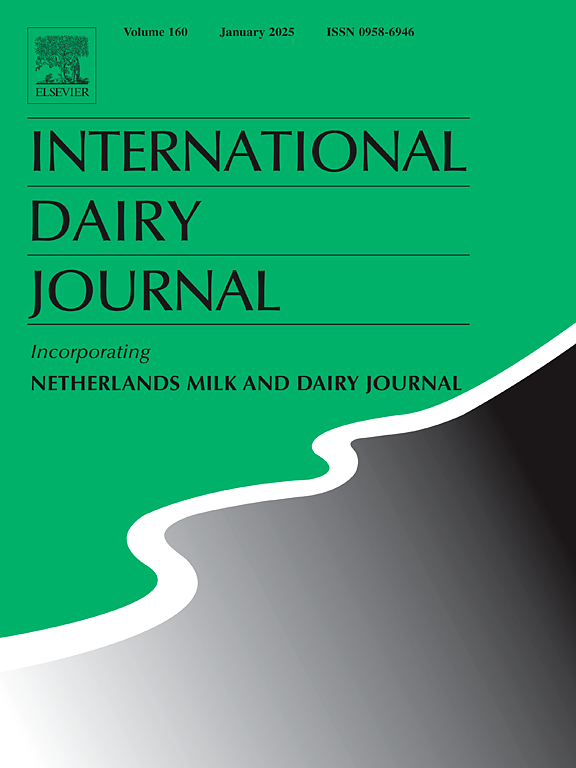The dynamic succession of the core microbial communities in pasteurized milk during refrigeration based on metagenomics
IF 3.4
3区 农林科学
Q2 FOOD SCIENCE & TECHNOLOGY
引用次数: 0
Abstract
The residual microorganisms in pasteurized milk undergo continuous changes during refrigeration. These microorganisms can metabolize the components of pasteurized milk, causing it to deteriorate and become inedible. The core microorganisms play a crucial role at different refrigeration stages. Using metagenomic sequencing, we analyzed the core microbial communities, succession patterns, and functional gene annotations of pasteurized milk during 14 days of refrigeration at 4 °C. The result showed that the dominant genus gradually changed from Acinetobacter to Corynebacterium in the early stage of the refrigeration period (0 - 4d), then to Pseudomonas in the middle stage (4 - 8d), and Pseudomonas became the absolute dominant genus after the following time (8 - 14d). KEGG annotation predicted that carbohydrate and amino acid metabolism were the metabolic categories with the most annotated functional pathways. CAZy annotation revealed that GHs and GTs were more annotated in the early and middle stages of refrigeration, whereas CBMs were predominantly annotated in the late and final stages (8-14d). These findings reflected potential functional shifts associated with microbial succession, laying a foundation for subsequent research on the quality and safety of pasteurized milk.
基于宏基因组学的巴氏奶冷藏过程中核心微生物群落的动态演替
巴氏奶中的残留微生物在冷藏过程中不断发生变化。这些微生物可以代谢巴氏奶中的成分,使其变质,变得不可食用。核心微生物在不同的制冷阶段起着至关重要的作用。利用宏基因组测序,我们分析了在4°C冷藏14天的巴氏奶的核心微生物群落、演替模式和功能基因注释。结果表明:冷藏初期(0 ~ 4d)优势菌逐渐由不动杆菌转变为杆状杆菌,中期(4 ~ 8d)为假单胞菌,后一段时间(8 ~ 14d)为假单胞菌绝对优势菌。KEGG注释预测碳水化合物和氨基酸代谢是功能途径注释最多的代谢类别。CAZy注释显示,GHs和GTs在冷藏的早期和中期被更多地注释,而CBMs主要在冷藏的后期和最后阶段(8-14d)被注释。这些发现反映了与微生物演替相关的潜在功能变化,为后续研究巴氏杀菌奶的质量和安全性奠定了基础。
本文章由计算机程序翻译,如有差异,请以英文原文为准。
求助全文
约1分钟内获得全文
求助全文
来源期刊

International Dairy Journal
工程技术-食品科技
CiteScore
6.50
自引率
9.70%
发文量
200
审稿时长
49 days
期刊介绍:
The International Dairy Journal publishes significant advancements in dairy science and technology in the form of research articles and critical reviews that are of relevance to the broader international dairy community. Within this scope, research on the science and technology of milk and dairy products and the nutritional and health aspects of dairy foods are included; the journal pays particular attention to applied research and its interface with the dairy industry.
The journal''s coverage includes the following, where directly applicable to dairy science and technology:
• Chemistry and physico-chemical properties of milk constituents
• Microbiology, food safety, enzymology, biotechnology
• Processing and engineering
• Emulsion science, food structure, and texture
• Raw material quality and effect on relevant products
• Flavour and off-flavour development
• Technological functionality and applications of dairy ingredients
• Sensory and consumer sciences
• Nutrition and substantiation of human health implications of milk components or dairy products
International Dairy Journal does not publish papers related to milk production, animal health and other aspects of on-farm milk production unless there is a clear relationship to dairy technology, human health or final product quality.
 求助内容:
求助内容: 应助结果提醒方式:
应助结果提醒方式:


